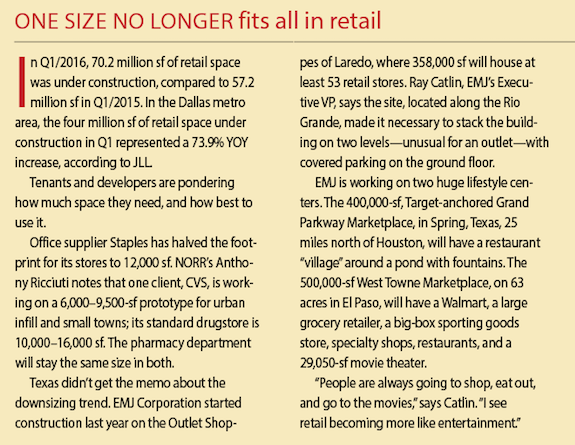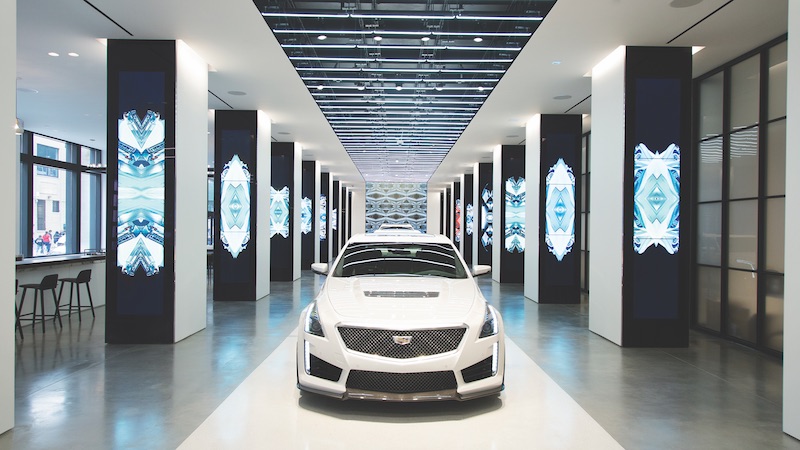When it debuted, in 1988, Fashion Mall, Plantation, Fla., was your typical anchor-driven retail leviathan. When it closed, in 2006, Fashion Mall was typical of huge shopping centers' fall from grace with many customers. Its prospects for resurrection, though, brightened last year, when Encore Capital Management acquired the property and announced plans to spend $300 million to turn it into Plantation’s new town square, dubbed 321 North.
TOP 90 RETAIL ARCHITECTURE FIRMS
Rank, Firm, 2015 Revenue
1. CallisonRTKL $205,964,000
2. Gensler $129,680,000
3. GreenbergFarrow $49,719,540
4. MG2 $45,652,293
5. Stantec $39,933,013
6. FRCH Design Worldwide $38,017,500
7. WD Partners $38,000,000
8. MBH Architects $28,126,062
9. NORR $20,326,054
10. P+R Architects $20,000,000
TOP 80 RETAIL CONSTRUCTION FIRMS
Rank, Firm, 2015 Revenue
1. VCC $574,787,663
2. PCL Construction Enterprises $556,581,503
3. Whiting-Turner Contracting Co., The $553,062,362
4. Shawmut Design and Construction $349,000,000
5. EMJ Corp. $287,137,603
6. Hoar Construction $235,377,000
7. dck worldwide $204,462,000
8. Turner Construction Co. $195,934,217
9. Beck Group, The $185,064,042
10. W.E. O’Neil Construction Co. $174,093,120
TOP 50 RETAIL ENGINEERING FIRMS
Rank, Firm, 2015 Revenue
1. Jacobs $167,960,000
2. Henderson Engineers $50,149,210
3. WSP | Parsons Brinckerhoff $33,622,000
4. Wiss, Janney, Elstner Associates $21,580,000
5. Core States Group $13,874,811
6. KLH Engineers $9,139,313
7. Wallace Engineering $8,200,000
8. Arup $7,105,331
9. Shive-Hattery $6,168,437
10. Highland Associates $5,900,000
Encore will bulldoze most of the mall, leave a nearby hotel and parking garage standing, and construct a 100,000-sf office tower, two apartment buildings totaling 700 units, and 73,000 sf of new retail space.
In its latest Retail Investment Forecast, Marcus & Millichap singles out the enhanced value of malls that can be repositioned as “lifestyle centers.” For instance, A/E firm NORR is working on a 300,000-sf project in Detroit that will include 25,000 sf of retail, fast-casual restaurants, a hotel, and apartments, says NORR VP Anthony Ricciuti, RA, OAA, NCARB.
Developers see malls as “part of a cocktail that creates a destination,” says Matt Billerbeck, AIA, SVP in CallisonRTKL’s Seattle office. His firm’s “Mall of the Future” report describes successful malls as walkable, transit accessible, anchored by food and experience, mixed use in nature, and connected to shoppers via smartphone and Internet-of-Things technology.
Successful retail is “more engaged with life on the street,” says Susanne Pini, HDR’s Director of Retail and Mixed-Use Practice. She points to the 864,000-sf, $200 million Woologong Central shopping center, 55 miles south of Sydney, Australia. Since its opening in 2014, 34 bars and restaurants have sprouted around it.
TECHNOLOGY: the ENEMY becomes the ENABLER
The National Retail Federation estimates total retail sales will increase 3.1% in 2016 over last year. But bricks-and-mortar dealers continue to struggle, as evinced by bankruptcies (Sports Authority, Aeropostale) and bleak earnings reports (Macy’s, Nordstrom, Target). Online sales, now 7.7% of the total, could hit 11% by 2018, predicts Forrester Research.
But dealers that once saw the Internet as a threat are finding ways to use technology. NORR’s Ricciuti says the Eastern Market in the Delta terminal at Detroit’s Metropolitan Airport is installing a “virtual maitre d,” an interactive hologram that will provide travelers with information and directions.
“Technology and mobility have created a new paradigm, in which stores and online shopping represent a single strategy to reach customers,” says Margaux Jaffa, VP, VOA Associates. Online dealers Amazon, Warby Parker, and Birchbox are opening stores, following Apple’s wildly successful example.
“It’s all about the experience,” says Jim Scarpone, Director of Business Development, Shawmut Design + Construction. A recent Shawmut project—Ralph Lauren’s three-story, 38,000-sf Polo flagship store in New York—is piloting RFID-enabled fitting rooms and touch-screen mirrors that sync with the store’s inventory and point-of-sale systems.
The mirrors, devised by Oak Labs, read bar codes on clothing tags. Numbers pop up on the mirror and shoppers can call up item details, and try different colors and styles. Requests for help are delivered via iPad to an associate, who can send a text that appears on the mirror with his or her name and photo.
The Oak Interactive Fitting Rooms can also provide dealers with tons of customer and inventory management data.
Shawmut just completed work on Cadillac House, in New York’s SoHo district. The 12,000-sf auto dealership and showroom opened June 2. It has an incubator space for designers, a coffee bar, a runway, and an art gallery. “It’s not just about selling cars,” says Scarpone, “it’s about selling the brand.”

RETURN TO THE GIANTS 300 LANDING PAGE
Related Stories
| Aug 8, 2022
Mass timber and net zero design for higher education and lab buildings
When sourced from sustainably managed forests, the use of wood as a replacement for concrete and steel on larger scale construction projects has myriad economic and environmental benefits that have been thoroughly outlined in everything from academic journals to the pages of Newsweek.
AEC Tech | Aug 8, 2022
The technology balancing act
As our world reopens from COVID isolation, we are entering back into undefined territory – a form of hybrid existence.
Legislation | Aug 5, 2022
D.C. City Council moves to require net-zero construction by 2026
The Washington, D.C. City Council unanimously passed legislation that would require all new buildings and substantial renovations in D.C. to be net-zero construction by 2026.
Cultural Facilities | Aug 5, 2022
A time and a place: Telling American stories through architecture
As the United States enters the year 2026, it will commence celebrating a cycle of Sestercentennials, or 250th anniversaries, of historic and cultural events across the land.
Sponsored | | Aug 4, 2022
Brighter vistas: Next-gen tools drive sustainability toward net zero line
New technologies, innovations, and tools are opening doors for building teams interested in better and more socially responsible design.
| Aug 4, 2022
Newer materials for green, resilient building complicate insurance underwriting
Insurers can’t look to years of testing on emerging technology to assess risk.
Sustainability | Aug 4, 2022
To reduce disease and fight climate change, design buildings that breathe
Healthy air quality in buildings improves cognitive function and combats the spread of disease, but its implications for carbon reduction are perhaps the most important benefit.
Multifamily Housing | Aug 4, 2022
Faculty housing: A powerful recruitment tool for universities
Recruitment is a growing issue for employers located in areas with a diminishing inventory of affordable housing.
Multifamily Housing | Aug 3, 2022
7 tips for designing fitness studios in multifamily housing developments
Cortland’s Karl Smith, aka “Dr Fitness,” offers advice on how to design and operate new and renovated gyms in apartment communities.
Building Materials | Aug 3, 2022
Shawmut CEO Les Hiscoe on coping with a shaky supply chain in construction
BD+C's John Caulfield interviews Les Hiscoe, CEO of Shawmut Design and Construction, about how his firm keeps projects on schedule and budget in the face of shortages, delays, and price volatility.

















